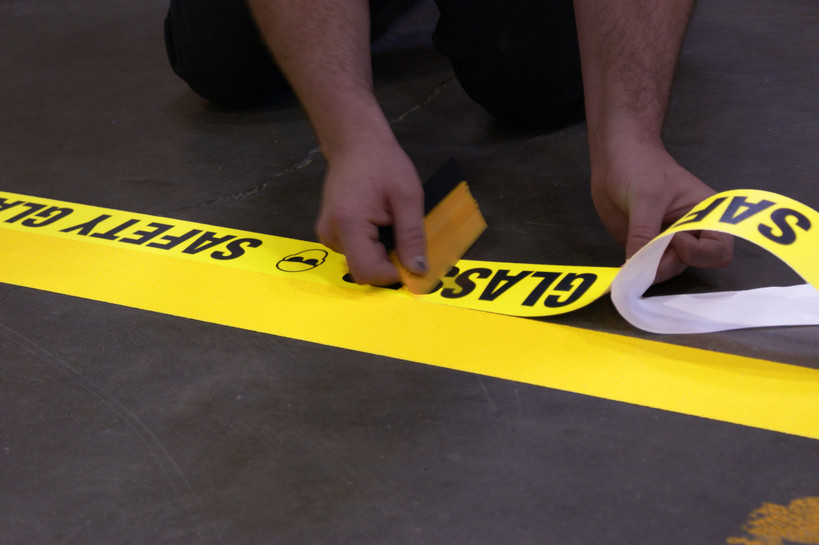Floor Marking Tape How-To Guide
Floor marking tape is a vital and versatile tool in many workplaces. It promotes safe navigation by directing traffic and identifying areas, objects, and hazards.
Floor tape comes in a variety of colors, styles, and materials, each with their own ideal application. Tapes can be reflective or non-reflective, and they can provide grip support to stabilize pedestrians, or a smooth surface to facilitate equipment traffic.
With so much diversity, it’s easy to see why it can be overwhelming finding the perfect tape for you – much less installing it. Therefore, we thought it could be helpful to have guidance in ensuring that your tape is properly installed.
The How-To Guide for Floor Tape
Regulations require that permanent aisles and passageways must be marked. Floor tape is a simple yet versatile product for marking vehicle lanes, safe pedestrian passage, and much more.
It’s easy to install, remove, and reuse, and it serves an abundance of diverse purposes. This guide provides tips and best practices for ensuring you get the most out of your tape.
The Floor Tape How-To Guide: Best Practices
To maximize longevity and optimize performance, there are a few care-taking tips that we recommend. These include preparing your space, choosing supplementary products wisely, and staying mindful of common issues.
1. Clean and Dry the Floor Prior to Installation
As with any paint or tape installation, it’s crucial that your floor be absolutely clean and dry prior to starting installation. Dust and debris can inhibit binding and result in suboptimal grip.
2. Avoid Chlorine-Based Cleaners in Your Facility
The chlorine in many floor cleaning liquids tends to leave a haze on the floor, even after rinsing. This haze can make it difficult for any adhesive to stick effectively. Simple Green and Greased Lightning are examples of non-chlorine cleaners.
If you must use a degreaser on your floor, ensure that you remove the degreaser thoroughly prior to applying any heavy duty floor tape.
3. Avoid Floor Tape Shrinkage
Corners that touch may shrink away and leave a gap after initial installation. Adding a small amount of Loctite Super Glue, or an equivalent, under the tape at the corners can keep joints tight.
4. Eliminate Air Pockets Under Floor Tape
Driving something heavy, such as a forklift, over the entire line is a good method to ensure your heavy duty marking tape has been properly applied.
Additionally, this removes any air pockets that may be stuck beneath your floor tape.
High Impact Zone Floor Tape Solutions
In high-traffic areas, pallets, skids, and other heavy objects tend to scrape on the ground. Applying heavy duty floor dots or heavy duty floor tape to create a dotted line has proven to be an effective solution.
How to Avoid Sharp Tape Bends in Floor Tape
- Apply your floor tape in a way that adheres to flat surfaces.
- Cut it, with either scissors or a utility-knife, when you arrive at an elevated part of the floor, such as at pillars, posts, table legs, etc.
- Avoid elevated sharp bends that will capture air and dirt beneath it.
Repairing Damaged Floor Tape
For a quick, professional-looking repair, lay a new piece of tape over the damaged area.
Then, cut through both the new and the old tape at each end of the damaged area, and peel out the old tape to apply the new for a perfect fit.
How-To Guide: More Tips for Using Floor Marking Tape
Miter Floor Tape Corners Like a Pro
Corners are easily and accurately mitered by overlapping two layers of floor tape at the corner, allowing several extra inches of product beyond the corner as shown.
Leave the backing on the last foot of the bottom layer, and remove the backing from the first foot of the top layer. Affix the top layer to the bottom layer at the desired angle.
Cut both layers together from the inside corner to the outside corner, discard excess pieces and press mitered corner to the floor. You can use a sharp utility blade with a straight edge to cut the miter.
Floor Tape Aisle Outline Width
Aisle width varies depending on how the aisle is utilized in the workplace. Aisles used for forklift trucks, or other mechanical equipment, will certainly be wider than aisles for pedestrian traffic.
OSHA recommends that aisles be at least 3 feet wider than the largest equipment to be utilized (or a minimum of 4 feet).
Storage room aisles containing flammable and combustible liquids should be at least 3 feet wide, and emergency exits should have a minimum width of 28 inches.
What Size of Floor Marking Tape to Use
The recommended width of aisle marking tape varies from 2 inches to 6 inches — therefore, any width of 2 inches or more is acceptable. Tape that is 4 inches wide tends to be the most popular as it’s a highly visible, strong, cost effective option.
Color Standards for Floor Marking Tape
OSHA and ANSI Z535.2 Safety Color Code designate yellow as the caution color. Therefore, a common method for marking is to use yellow stripes for marking physical dangers, such as stumbling, falling, or tripping hazards.
For more information on floor tape color standards, see:
How-To: Find Trusty Floor Marking Guidance at ifloortape.com
At ifloortape.com, we have the expertise, experience, and product catalog to ensure that you can maximize productivity in your workplace. We even offer custom colors and sizes!
If you want more tips for properly installing your heavy duty floor marking tape, then
reach out to our team today.

 US Dollars
US Dollars
 Canadian Dollar
Canadian Dollar
 Mexican Peso
Mexican Peso
 Brazilian Real
Brazilian Real
 Colombian Peso
Colombian Peso
 Chilean Peso
Chilean Peso

